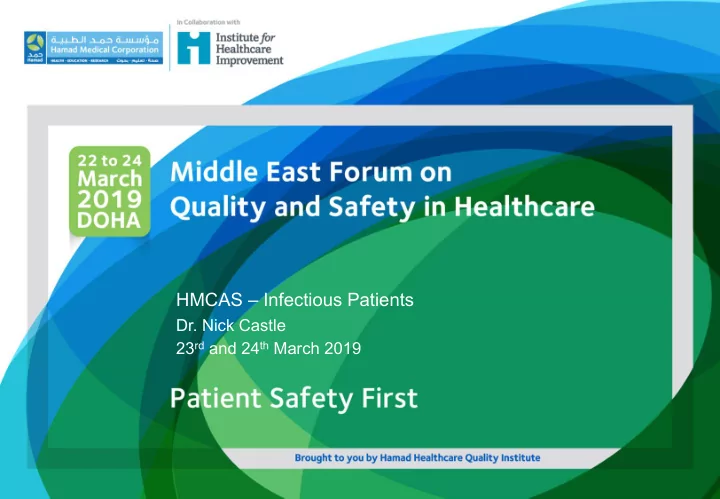

HMCAS – Infectious Patients Dr. Nick Castle 23 rd and 24 th March 2019
As part of our extensive program and with CPD hours awarded based on actual time spent learning, credit hours are offered based on attendance per session, requiring delegates to attend a minimum of 80% of a session to qualify for the allocated CPD hours. • Less than 80% attendance per session = 0 CPD hours ME Forum 2019 Orientation • 80% or higher attendance per session = full allotted CPD hours Total CPD hours for the forum are awarded based on the sum of CPD hours earned from all individual sessions.
Conflict of Interest I have no conflict of interest or disclosure in relation to this presentation.
Learning Objectives At the end of this session, participants will be able to: 1. Risk 2. PPE for transportation 3. What can you do 4. Decontamination of ambulance
10.00% 12.50% 15.00% 17.50% 20.00% 22.50% 25.00% 0.00% 2.50% 5.00% 7.50% Other : Pain, Unknown Cause Top diagnosis transported by Other : Nothing Abnormal Detected GI GU : Acute Abdomen HMCAS Trauma - Soft Tissue… Other : Febrile Illlness • 2.5% of all ambulance service contacts are GI GU : Renal Colic Neurological : Headache for respiratory illness (raising to 3.5% in GI GU : Gastroentiritis the under 14) Trauma : Blunt Trauma Trauma : Laceration • 6% of all ambulance service contacts are Respiratory : Upper Respiratory Infection for febrile illness (raising to 12.5% in the Other : Exacerbation of Chronic Medical… Cardiovascular : ACS Other under 14) Respiratory : Lower Respiratory Infection Endocrine : Hyperglycemia • The ambulance service is commonly the Respiratory : Asthma FIRST point of contact – high Trauma - Sprain / Strain awareness is required Neurological : Seizure Cardiovascular : Hypertensive Emergency • Identify it’s a risk Neurological : Syncope • Call National Command Centre Neurological : Psychiatric Event Trauma : Closed Fracture • Step back from patient and don PPE Other : Allergic Reaction Transport : IFT/PTS Environmental : Heat Illness
High risk PPE – for the infectious patient • Buddy assessor (duty supervisor) to ensure correctly worn • “Head to toe” waterproof coverall • Double Gloves • N95 mask (all staff are fit tested on induction • Face splash mask • Patient to wear a ‘mask’ • Inform the hospital of possible infectious patient
Extremely High risk PPE – for the infectious patient • Typically NOT required for respiratory illness • Provides biologically filtered air • Higher grade hand, face and skin protection • Fully isolated patient. ALMOST no possibility to provide any clinical care
Title Note how the visor is tilted downwards with the non transparent hood moving forward to occlude the intubator’s vision when attempting to intubate on the floor. This was universally commented on by all Body text. interviewees as the reason for failed on floor intubation.
Decontamination of ambulance • Immediately removed from • Ambulance design • NO porous material service • Wipe clean services • Air the ambulance • hydrogen peroxide ‘fogging’ • Remove all electronic items ‘cleaned’ with bleach based product • APT testing • If clear, social clean the ambulance • Return to operation – 2 hours
Have a high index of suspicion ‘its in the history’ Protect yourself and others Simple things saves lives .
Thank you.
Recommend
More recommend